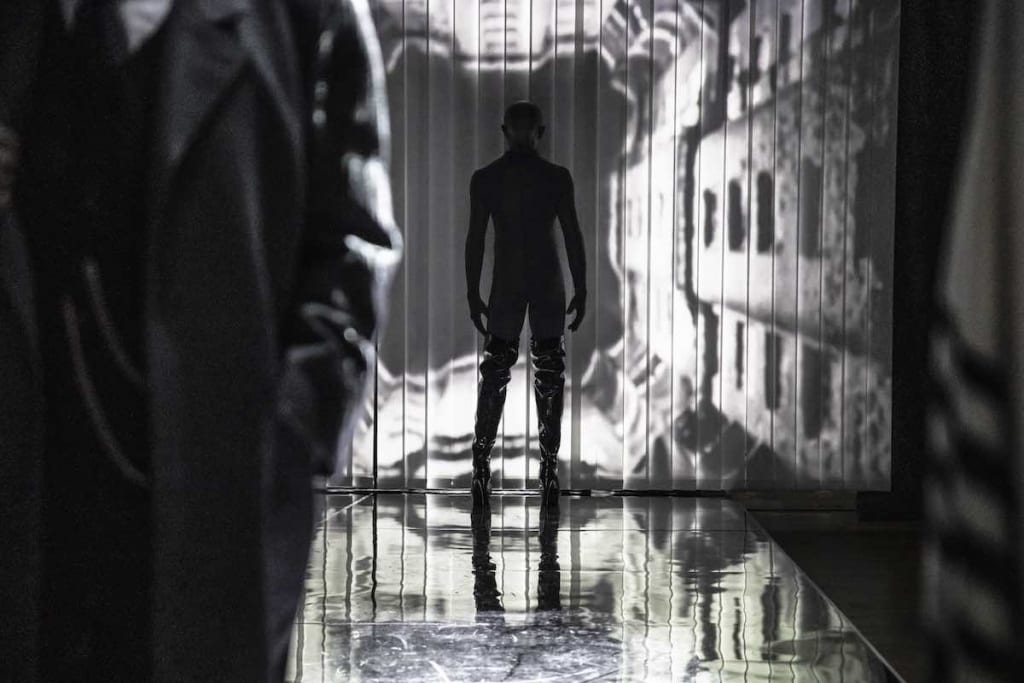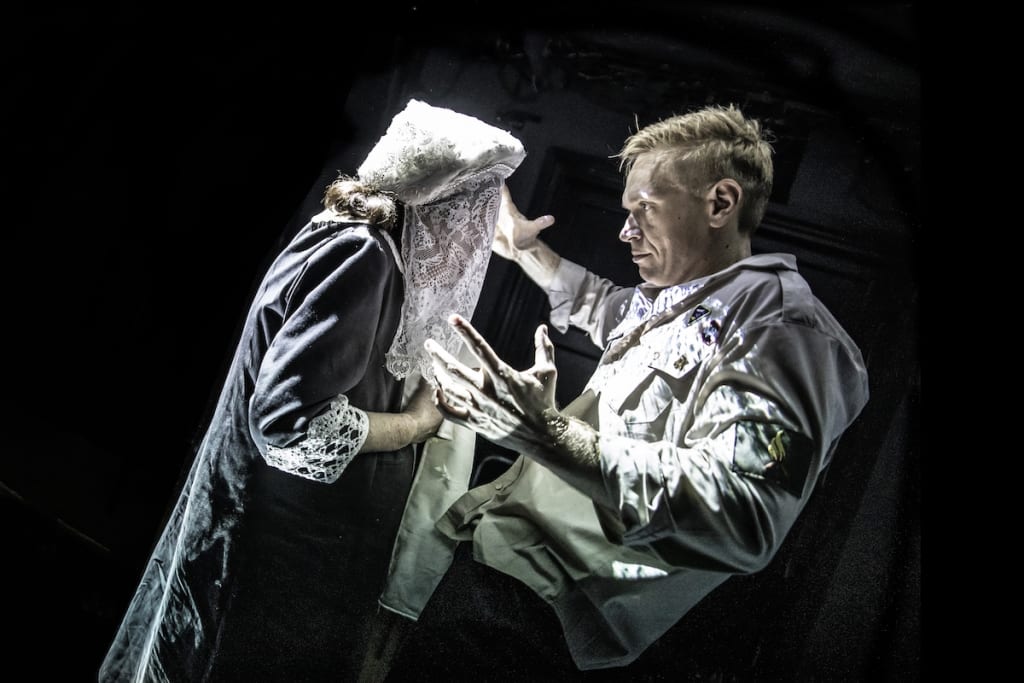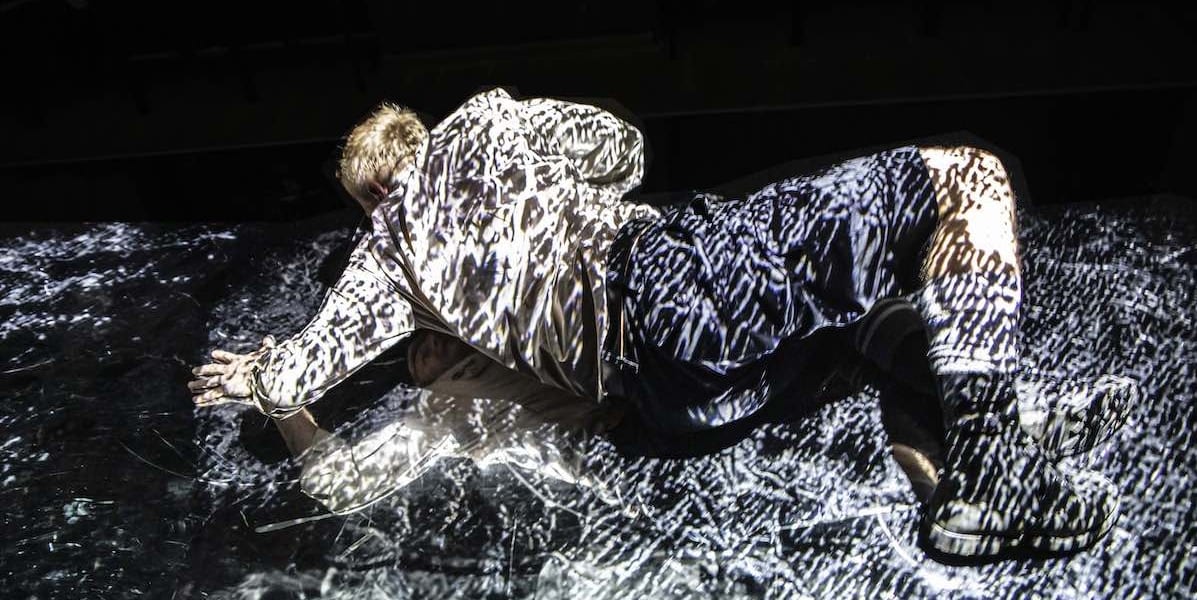The Ester Rachel and Ida Kamińska Jewish Theatre in Warsaw remains, together with Teatrul Evreiesc de Stat (the State Jewish Theatre) in Bucharest, the only Yiddish speaking theatre in Europe, although currently most of its productions are successfully performed in Polish.
Staging The Tempest in the pre-war Yiddish translation by Yosef Goldberg for the Polish audience was both courageous and risky, but the Jewish Theatre in Warsaw, against the historical and political obstacles, does move forward and for the past few years keeps the place in the Polish theatre premier league. Der Szturem. Cwiszyn – The Tempest. In between (enriched with the short memories saved in Ringelblum’s Archive, Kadish & Song of Songs) impresses with gentleness, modesty and the sound of Yiddish confronted with the memory of the war when Polish Jews were killed in the Holocaust.

Prospero’s island is narrow: few meters of the glittering catwalk and almost no props. On both sides of the catwalk, we watch B&W pictures of demolished Warsaw with its partial buildings, destroyed streets, as if the reality of the island had been designated by the past and eternally condemned to commemoration. The audience is seated alongside the catwalk, very close to the actors, which prevents from keeping the distance, especially when sometimes they look a spectator in the eyes. Two screens in the middle of the room serve the Polish audience with the translation.
The first part is based on shortcuts of The Tempest: scenes between Prospero and Miranda, Kaliban’s friendship with Miranda, the appearance of Trinkulo and Stefano on the island. However, it turns out pretty quickly that the island of Prospero’s is a multilayered metaphor. On one hand, it stands for a no man’s land in the middle of nowhere with no trace of time, but on the other, it uncovers its fundamental meaning: tough past and the exile about which Prospero teaches Miranda, fault, crime, revenge, impossible forgiveness and reconciliation are all rooted in the wartime. The core of the performance is based on Jewish songs and Hebrew prayers and, what is most important, the documents from Emanuel Ringelblum Archive, which is The Underground Archive of the Warsaw Ghetto: a unique collection of documents that are one of the world’s significant testimonies about the extermination of Polish Jewry – both individuals and communities.

The Tempest. In between directed by Damien Josef Neć is all about talking and emotional interaction, as actions always refer to the Holocaust. When Neć opens the narrative to the memory of Shoah the plot of The Tempest is paused; rituals from the drama become damaged, seem no longer successful – when Ariel arranges the marriage for Miranda, he recites kaddish, a prayer for the dead. It is a very powerful picture: Ariel/Ferdinand passionately speaks out the Hebrew words standing between Prospero and Antonio, who hold tallit above him as a chuppah. Speaking Yiddish becomes not only a very moving concept (even not knowing the language one can deeply feel the seriousness and weight of the words and its poetic melody clearly expressed by the actors, far from the folk tradition) but most of all, a tribute to those whose tradition was brutally cut down and hardly reborn after the WW II as it happened in Warsaw, where 1/3 citizens were Yiddish speaking. Coming back to the theatrical context, Yiddish speaking Jews are missing, but apparently never forgotten the audience, at least in the Jewish Theatre in Warsaw.
After the archival intermedium the narrative restores the Shakespearian plot: Miranda leaves the Island, Prospero is left helpless, Ariel calms down the tempest and, in the end, he lies on the floor like a hunted bird, awkward ghost, exactly in the same way as he opens the performance. As Prospero speaks in his final monologue, heard outside the stage as a voice of almighty: ”And my ending is despair”. Forgiveness cannot happen as long as memory is hunting Prospero.
Der Szturem. Cwiszyn by Neć is mostly played by the actors, who are cast beyond sex and age: Miranda (Wanda Siemaszko) is an elderly lady wearing a girlish skirt, Trinkulo (Joanna Przybyłowska) and Stefano (Barbara Szeliga) wear scout uniforms, Kaliban (Marcin Błaszak) moves sharply, leaning back on bended knees, Ariel (Jerzy Walczak) resembles a half-mermaid wearing black leather high-heeled boots reaching up to his thighs and Antonio (Marek Węglarski) wears white pants and a tallit. Prospero (Henryk Rajfer), in the part based on the archive documents, wears a long coat with a Magen David armband. He also has a short-improvised scene (in Polish) in which he says that „your” death was better than the „Jewish” one: hidden and with no dignity. The ensemble of the Jewish Theatre in Warsaw one more time proves its strength and uniqueness in balancing between their repertoire and the new expression, building togetherness on stage and solid determination in keeping the memory of its Yiddish past.
The Jewish Theatre in Warsaw celebrates the 70th anniversary and Der Szturem. Cwiszyn restores the tradition of staging the plays in Yiddish, but not necessarily from the Jewish literature. And it definitely works.
Summary of the review in Polish
Pierwsza premiera „Burzy” Szekspira w jidysz miała miejsce w Łodzi w 1938 r. w Folks Un Jungt Theater. W 1939 r. grana była dla publiczności warszawskiej. Zarówno przez krytyków żydowskich, jak i polskich okrzyknięta została sukcesem teatru żydowskiego w Polsce. Sukcesem, który napawał optymizmem i wiarą we wspólny polsko-żydowski świat, mimo rozgrywających się poza sceną coraz bardziej antysemickich aktów, rosnących w siłę faszystów. Słowa Kalibana, który w inscenizacji Leona Schillera był symbolem nowego barbarzyństwa: „gdy spalisz jego książki, straci on całą swą władzę”, brzmią dzisiaj jak zapowiedź Zagłady. Po okropieństwach II wojny światowej i Zagłady nigdy nie wrócono w Polsce do idei wystawiania Szekspira w jidysz. Aż do dzisiaj. Najnowsza realizacja „Burzy” z
dramaturgią i w reżyserii Damiana J. Necia, jest spektaklem uniwersalnym i ponadczasowym. Z postaciami bez wieku i płci, walącym się miastem w tle, jest zawieszonym w czasie obrazem po katastrofie. Może dziać się wszędzie, choć język jidysz w spektaklu określa miejsce i czas akcji, narzuca interpretację – nie sposób jej czytać bez Zagłady, tej dziejowej burzy, jaka zmieniła świat. Bardzo interesuje nas, jak wybrzmi ten dramat 82 lata po łódzkiej premierze „Burzy” w podzielonej wewnętrznymi sporami Polsce, czy jidysz stanie się metaprzestrogą przed demonami powtarzającej się historii – mówi Damian J. Neć, reżyser spektaklu
W przedstawieniu obok „Burzy” Szekspira w przekładzie na jidysz Yosefa Goldberga wykorzystane zostaną również fragmenty Archiwum Ringelbluma oraz „Lamentacji Jeremiasza” i „Pieśni nad Pieśniami”. W spektaklu występują: Henryk Rajfer (Prospero), Jerzy Walczak (Ariel/ Ferdynand), Wanda Siemaszko (Miranda), Barbara Szeliga (Stefano), Joanna Przybyłowska (Trinkulo), Marek
Węglarski (Antonio) i Marcin Błaszak (Kaliban).
Reżyseria i dramaturgia – Damian Josef Neć. Za scenografię, kostiumy i wizualizacje odpowiadają Marta Wieczorek i Maciej Czuchryta. Muzyka – Sławomir Kupczak. Choreografię opracował Szymon Dobosik. Za przygotowanie wokalne odpowiada Teresa Wrońska. Konsultacje językowe, przystosowanie scenariusza jidysz i transliteracja – Aleksandra Król.

